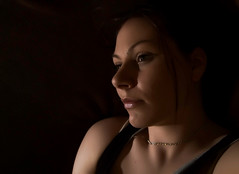Photography literally means to write with light yet so often it is overlooked and misunderstood. People tend to try to replicate the sun by using flash indoors, built in flash, on camera flash. The light coming directly from the camera creates very hard shadows and gives that washed out white look in snapshots. Natural light is wonderful as you can see easily see where it’s coming from its intensity, where the shadows will fall, and how the shot will look before shooting.
Window light is perfect. Your goal is to get a beautiful window lit portrait; now you have to find the light. Go from room to room metering the light from your windows and find the best one. Note the size, location, and light readings from the different windows. This will help you learn to find light anywhere. The challenges of working with customers on location, in their homes, will be always be big, and these exercises help sharpen our skills.
Ask yourself some questions when doing this. I keep a small journal where I’ve always jotted things such as this down. I carry it with my gear always; it’s not so small anymore though.
• What was the size and shape of the window?
• What time of the day is the light being metered? Early morning? Afternoon?8am11am noon
• Was it a south, north, east, or west window?
• What was the weather like? Sunny, overcast, raining, snowing?
• Was there something outside the light was reflecting off of? Bouncing off of a white building, water, snow?
• Does the light become any softer/harder at different times of the day?
Asking questions like these are important in understanding how light changes and how it will look coming though different sizes and shapes of windows.
Choose your window and place your subject in different positions. Place your subject at a 45 degree angle in the window. See how the light falls on your subject. A nice 45 degree angle will usually allow for the light to fall on both sides of the face. Don’t like the light, try moving your subject closer to or further away from the window, change the degree of obliquity, or reflect some light back on to darker side of your subjects face. Keep in mind that it’s the shadows that give the shot its depth and three dimensional feel. Meter the bright side of the face as not to blow the highlights.
Practice, ask yourself questions, and show us your beautiful (window lit) portrait!
Got the window portrait down? Take it outside! Go out at different times of the day and meter the light. Ask yourself questions about that light, study it.
Tuesday, February 3, 2009
Subscribe to:
Posts (Atom)
